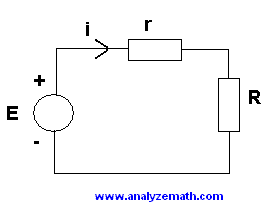
The first derivative is used to maximize (optimize) the power delivered to a load in electronic circuits.

Solution to the Problem
We first express power P in terms of E, r, and the variable R by substituting i = E(r+R) into P = Ri2.
P(R)=RE2(r+R)2
We now differentiate P with respect to the variable R
dPdR=E2[(r+R)2−R2(r+R)][(r+R)4]=E2[(r+R)−2R](r+R)3=E2(r−R)(r+R)3
To find out whether P has a local maximum, we need to find the critical points by setting dPdR=0 and solve for R.
Since r and R are both positive (resistances), dPdR has only one critical point at R=r. Also for R<r, dPdR is positive and P increases, and for R>r, dPdR is negative and P decreases. Hence P has a maximum value at R=r. The maximum power is found by setting R=r in P(R)
P(r)=rE2(r+r)2=E24r
So in order to have maximum power transfer from the electronic circuit to the load R, the resistance of R has to be equal to r.
As an example, the plot of P(R) for E=5 volts and r=100 Ohms is shown below and it clearly shows that P is maximum when R=100 Ohms = r.
